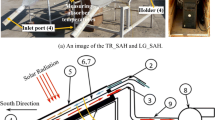Abstract
In this study, an attempt is made to improve the energy and exergy performance of solar air heater by employing double pass with different absorber surface geometries (roughened, finned, and v-corrugated wire mesh) in the second pass, and also by mounting longitudinal fins in the back side of the absorber plate (first pass). The effect of varied mass flow rate and solar intensity on temperature rise of air, energy efficiency, exergy gain and pressure drop at steady state condition was determined for different types of solar air heaters utilizing an indoor solar simulator. The temperature rise of air, thermal efficiency and exergy gain depends on mass flow rate, surface geometries of absorber and solar intensity, whereas the pressure drop depends on mass flow rate and surface geometries of absorber.










Similar content being viewed by others
References
Sopian K, Supranto Daud W R W, Othman M Y and Yatim B 1999 Thermal performance of the double pass solar collector with and without porous media. Renew. Energy 18: 557– 564
Ramadan M R I, El Sebaii A A, About Enein S and El-Bialy E 2007 Thermal performance of a packed bed double pass solar air heater. Energy 32: 1524–1535
Omojaro A P and Aldabbagh L B Y 2010 Experimental performance of single and double pass solar air heater with fins and steel wire mesh as absorber. Appl. Energy 87: 3759– 3765
El-Sebaii A A, Aboul-Enein S, Ramadan M R I, Shalaby S M and Moharram B M 2011 Thermal performance investigation of double pass-finned plate solar air heater. Appl. Energy 88: 1727–1739
Ozgen F, Esen M and Esen H 2009 Experimental investigation of thermal performance of a double flow solar air heater having aluminium cans. Renew. Energy 34: 2391–2398
Karsli S 2007 Performance analysis of new design solar air collectors for drying applications. Renew. Energy 32: 1645–1660
Gupta M K and Kaushik S C 2008 Exergetic performance evaluation and parametric studies of solar air heater. Energy 33: 1691–1702
Esen H 2008 Experimental energy and exergy analysis of a double-flow solar air heater having different obstacles on absorber plates. Build. Environ. 43: 1046–1054
Akpinar E K and Koçyiğit F 2010 Experimental investigation of thermal performance of solar air heater having different obstacle on absorber plates. Int. Commun. Heat Mass Transfer 37: 416–421
BSI-BS 6757-1986 British standard methods of test for thermal performance of solar collectors. London: British Standard Institution
JIS A 4112-1994 Japanese industrial standard solar collectors. Revised 1994-20-01, Japan: Japanese Standards Association
Prasad B N 2013 Thermal performance of artificially roughened solar air heaters. Sol. Energy 91: 59–67
Yang M, Wang P, Yang X and Shan M 2012 Experimental analysis on thermal performance of a solar air collector with a single pass. Build. Environ. 56: 361–369
Mittal M K and Varshney L 2006 Optimal thermohydraulic performance of a wire mesh packed solar air heater. Sol. Energy 80: 1112–1120
Sun W, Ji Jie and He Wei 2010 Influence of channel depth on the performance of solar air heaters. Energy 35: 4201– 4207
Holman J P 1994 Experimental methods for engineers. 6 th ed. Singapore: McGraw-Hill Book Co
Karim M A and Hawlader M N A 2006 Performance evaluation of a v-groove solar air collector for drying applications. Appl. Therm. Eng. 26: 121–130
Mohamad A A 1997 High efficiency solar air heater. Sol. Energy 60 (2): 71–76
El-khawajah M F, Aldabbagh L B Y and Egelioglu F 2011 The effect of using transverse fins on a double pass flow solar air heater using wire mesh as an absorber. Sol. Energy 85: 1479–1487
Prasad S B, Saini J S and Singh Krishna M 2009 Investigation of heat transfer and friction characteristics of packed bed solar air heater using wire mesh as packed materials. Sol. Energy 83: 773–783
Dhiman P, Thakur N S and Chauhan S R 2012 Thermal and thermohydraulic performance of counter and parallel flow packed bed solar air heaters. Renew. Energy 46: 259–268
Lin W, Gao W and Liu T 2006 A parametric study on the thermal performance of cross-corrugated solar air collectors. Appl. Therm. Eng. 26: 1043–1053
Author information
Authors and Affiliations
Corresponding author
Rights and permissions
About this article
Cite this article
VELMURUGAN, P., KALAIVANAN, R. Energy and exergy analysis in double-pass solar air heater. Sādhanā 41, 369–376 (2016). https://doi.org/10.1007/s12046-015-0456-5
Received:
Revised:
Accepted:
Published:
Issue Date:
DOI: https://doi.org/10.1007/s12046-015-0456-5




